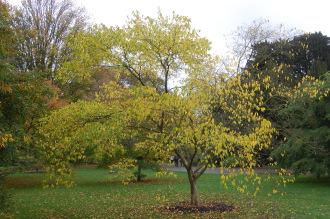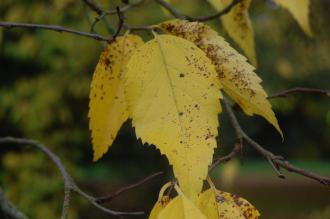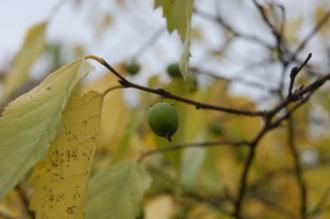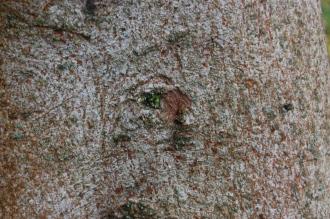
Aphananthe aspera Autumn (08/11/2015, Kew Gardens, London)
Position: Full sun to light shade
Flowering period: Spring
Soil: Moist, well drained
Eventual Height: 20m
Eventual Spread: 15m
Hardiness: 7a, 7b, 8a, 8b, 9a
Family: Cannabaceae

Aphananthe aspera Autumn Leaf (08/11/2015, Kew Gardens, London)
Aphananthe aspera is a deciduous tree with a rounded to spreading crown. Its mid green leaves are ovate to elliptic with serrate margins, have a rough surface, up to 10cm long and 5cm across. Its branches are yellow/ green when young maturing to brown in their second year. Its trunk may achieve a diameter of up to 50cm. Its grey/ brown bark is longitudinally fissured. Its monoecious flowers are small, appear solitary in its leaf axils. Its green/ black fruit is a globose drupe and up to 13mm long.
Aphananthe aspera, commonly known as Muku Tree, is native to Japan, Korea, east and north China, Taiwan and Vietnam. In its native habitat it grows in lowlands and stream banks.

Aphananthe aspera Fruit (08/11/2015, Kew Gardens, London)
The etymological root of the binomial name Aphananthe is derived from the Greek afanhs meaning ‘unseen’ and anqe meaning ‘flower’. Aspera is from the Latin meaning ‘jagged’.
The landscape architect may find Aphananthe aspera useful as a small tree with attractive autumn leaf color.

Aphananthe aspera Bark (08/11/2015, Kew Gardens, London)
Ecologically, Aphananthe aspera fruit are attractive to some mammals and birds.
Aphananthe aspera prefers moist, fertile, well-drained soils. It tolerates most pH of soil.
Aphananthe aspera requires little maintenance.

Landscape Architecture

